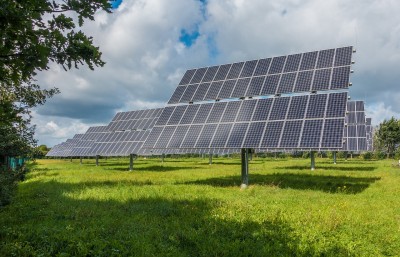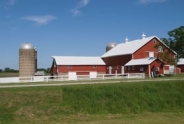Solar Leases and Farms
Amy Barkley, Livestock Specialist
Southwest New York Dairy, Livestock and Field Crops Program

Solar Leases and Farms
Article by Caroline Hunt, CCE Yates County
This article summarizes takeaways from the workshop, "Navigating Solar Lease Agreements and the Solar Development Process: A Program for NY Farmers and Rural Landowners".
The Climate Leadership and Community Protection Act (CLCPA) has set the goal that 70 percent of the state's electricity must come from renewable sources by 2030. Currently solar accounts for one percent, wind energy for three percent, and hydroelectric produces 23 percent of New York's power. In order for the state to meet the current goal, solar energy production, along with other renewable energy sources, must increase substantially.
Good farmland and good solar land have a lot in common. Many farmers in our region have been approached by solar developers interested in leasing land. There are real benefits to consider, not the least is a guaranteed long-term passive income source that can help smooth out the feast and famine cycle that is farm income. On Tuesday, October 26th, Cornell University held a statewide workshop delving into some of the issues that may come up for landowners when navigating the solar leasing process.
This article will share some of the major points on what to pay attention to in solar leasing contracts as discussed at the workshop. This article is not intended as legal advice, more of a checklist to help you think about your options. A company will try to push you to make decisions as quickly as possible. It is well worth your time to go through any contract slowly and make sure you understand all the implications before signing. Hiring an attorney who is well-versed in renewable energy contracts to help guide you through the process, is a wise investment.
Is my land a good fit for a solar farm?
There are several attributes that make land attractive to solar developers. Marketable properties are easy to connect to the grid with lines able to handle the increase in power generation and transmission, with existing or easy access to a 3-phase line. Putting in 3-phase lines costs approximately $100 a foot or a little over $500,000 a mile. NY Independent System Operators estimate that NY will require nearly 1,000 miles of new transmission lines to support the number of solar/wind projects needed to meet the CLCPA goal. If your farm can easily connect to 3-phase power, it is much more attractive to solar developers.
Geography also influences which land is most desirable for solar installations. Land without a slope is preferable though a slight south slope may be acceptable. Land clear of trees and structures make installation easier. Wetlands and land located along streams are not usually good options for solar development.
Other nearby solar power generation projects may also influence whether your land is viable. There is limited capacity in the existing transmission lines. Once that capacity is filled then any further projects are not viable. The hope is that there will be funding for upgrading electrical lines in the federal infrastructure package but that is not a guarantee.
Letters of Intent and Options: the precursors to the leasing process:
The three documents that you will need to be familiar with are letters of intent, options, and leases. Many companies are pushing for landowners to sign letters of intent instead of an option. An option is a legal document while a letter of intent is a written understanding but not a legally binding document. Letters of intent are written statements of the company's intention to lease your land based on certain expectations. Although letters of intent are not legally binding, many companies will fight as if it is if you try and back out. Letters of intent give companies some site control without protections for property owners such as insurance and indemnification of liability in case of an accident. An option agreement is more formalized and allows the developer to have the exclusive right for an agreed-upon period-of-time to enter into a formal lease agreement. It's important for you to add anything that you want to do with the land during the option period to the option. This could include grazing or growing crops on the optioned acres. Once the option is signed it will be difficult to impossible to add any flexibility to it.
An option is a more secure choice for a landowner. Negotiating the option at the beginning of the project can also help you make the decision on whether or not you want to work with the developer. A different company may be a better fit and it's generally better to decide that early in the process versus spending months or years before you reach the lease negotiation.
During the option period your land will be inspected and evaluated for suitability including exploration of municipal approval of the project if needed and a utility study. Title review will look also at pipeline rights (if natural gas company has ability to rip out solar to get to pipeline then that's not a workable location), utility easements, other rights of way, hunting rights and farm leases.
Things to pay attention to in the option paperwork:
Land Use
The company needs to commit to a certain amount leased to make the process worth your time. You don't want to commit to them and find out they are only committing to leasing 5 acres out of the 50 you were discussing.
You and the developer need to decide together and have the language in the lease say what land will be developed. Many leases are written so that developer can place their panels wherever they decide on the parcel. Companies will always push back on this. You should be reasonable, but it needs to be in writing where the panels will be installed. Make sure both you and the company are clear on where the easements are. When these are not agreed upon and clearly written, farmers have found themselves unable to access some of their fields or with solar access roads through their fields and no recourse. One option is to mark out the areas where you don't want development and where you need right of ways and let them choose their location from the remaining land.
Property rights:
Reserve rights such as timber, rock, gravel, oil, gas and hunting rights to keep land saleable and useable. An option is a legally binding document and you need to make sure you maintain maximum flexibility during the option period.
Indemnification:
You want to be protected from the company's insurance in case one of their workers is injured. Make sure that the company policy will cover any damages to your land and not hold you liable for any damage to their property or staff injuries.
Inspections:
The company should give notice of inspections as well as repair damages from inspections. It's nice to know when they'll be coming through as well having it in writing that they must clean up after themselves.
Financial Considerations
Requiring a small annual rent payment from the developer for the length of the option period will encourage the developer to decide more quickly on whether or not your property is one which they would like to develop for solar.
Any attorney fees you pay should be addressed in the option and be reimbursed by the developer- these may add up during the negotiation process!
Option years- companies will try and give themselves as many years as possible before they give you a lease. This reduces your flexibility and ability to plan for the future, especially as an option doesn't automatically mean that you will end up with a lease. Many companies will get options on a large number of properties to maintain a competitive advantage while they are making up their minds on projects. Keeping the option time period short will force the company to either give you a lease or open you up to other offers.
Financial flexibility- Make sure you keep your right to transfer land and mortgage your land to keep your flexibility and ability to finance. This is really important for long-term planning and needs to be addressed both in the option and in the lease.
Solar Leases
The lease is the final legal document. This is your final chance to make sure that the lease is set in such a way to maximize your flexibility and income while minimizing disruptions to your farm. Solar leases are generally for 30-40 years, often with the right to renew, so it's important to think about your farm succession plan prior to signing the lease as it will transfer to the next generation and owner. It is important to review the lease with a lawyer who has experience with renewable energy leases. Also important- don't plan on the lease income in the near future. Lease payments can be a steady source of income but generally don't start paying until the panels are producing power. It may take 5 or more years to reach that point.
Areas to Pay Attention to in the Lease Paperwork:
A typical solar lease may contain the following language: "…the right to build the project on the leased area including but not limited to the right to construct: solar panels, overheard line, electric transformers and substations, energy storage facilities, telecommunications…"
Be careful of the words in bold and underlined above. Make sure that you exclude them from the lease language and have the company negotiate a separate lease for substations and energy storage facilities. You can negotiate a lot of revenue for these in addition to your solar lease. 95% of landowners are giving these away in the lease and losing out on substantial income from a secondary lease.
Rent in the lease- Some leases are paid per acre and some are paid by power generation. Payments will also vary by region and load zones. All leases have confidentiality provisions, as companies don't want people to know what they are paying for leases. One of the speakers saw offers from 1,100 an acre to 2,000 an acre. Some other offers were on installed capacity basis which worked out to $2,000 per acre.
Keep asking questions until you have enough information to compare apples to apples. Also pay attention to the escalation rate over time. The escalation rate is the amount the rent is increased each year. A generous payment in 2021 will not look generous in 2040 dollars. 2% annual escalation rate is good, or you can tie the escalation rate to inflation rates. You may take a lower monthly payment now and still end up ahead with a more generous escalation rate.
Acres leased- Make sure it's clear in the lease if you will be paid rent for leased acres or usable acres. Developers may end up using very little of the leased acres for solar panels. Make sure you are being paid for all acres leased by the company, not just the ones they utilize for power generation. Also ensure that the lease will be paid through property restoration, after the panels are decommissioned. This motivates the company to actually decommission panels when they are no longer utilizing them and will get your land back to a usable state more quickly.
For leases that are based on Megawatt production, clarify if that is a fixed number or sliding based on production. It's also important to limit the company to 6-7 acres of land per Megawatt so you aren't providing them with access to unlimited land.
If your lease is based on per-acre rented you will need a survey of actual acres used for the project. This
may differ from the number of acres optioned but if you addressed the minimum acres to be leased in
the option, they will lease at least that quantity.
Clarify in writing the timeline to commence construction. Generally, you won't start receiving payments
until the panels are producing power. Setting a time frame in writing between signing of the lease and
when the company commits to commencing construction will help reduce the time between lease
signing and lease payments.
Even though you should have an indemnification clause, you need an insurance clause to back it up and
protect you and your land. This insurance policy should be paid for by the solar company. Make sure to
consider what an acceptable level of insurance should be in the future. $5-6 million for a 30-year lease is
currently a good level of insurance according to the seminar speakers.
Timber damages should be addressed in the lease. if they are taking trees down to install the panels,
make sure they reimburse you for the loss.
Reserve your rights for the property; oil/gas, timber/rock/gravel, the right to transfer and mortgage the
land need to be protected in writing.
Property taxes- The developer or owner of the solar installation should pay any property taxes on the solar facility land; however, you are generally responsible for an increase in the amount of any of your tax bill due to its use. NYSERDA has a publication- "Solar Installations in Agricultural Districts" which covers these issues in much more depth.
When you send in your forms to the tax assessor for your agricultural assessment, you are committing the land to agricultural use for the next 5 years. If your land is located outside of an agricultural district then you are committing the land to 8 more years of agricultural use. You may put up personal or farm level solar installations which can produce up to 110% of your farm's energy needs without losing your agricultural assessment. However, if your land is leased to a solar developer for a larger solar array project, then you will pay a penalty for removing your land from agricultural use.
The developer also should commit to paying any penalties you incur for the change in land usage such as the loss of ag exemptions or conservation easements.
Other areas worth negotiating:
Visual impact of the project should be considered during lease negotiations. Try to negotiate underground transmission lines. What visual barriers the company will install should also be laid out in the lease. The speakers suggested fencing lined with green material which may blend in better with the surroundings. Borders of evergreen vegetation will also reduce any visual impact of the solar farm on the rest of the property. If it's near a property line, keep your neighbors' views in mind as well.
Eliminate right of first refusal for land purchases. If the company has right of first refusal to purchase your land it makes it difficult to negotiate with third parties if you do choose to sell your farm in the future and may make succession planning difficult if you plan for your children to purchase your farm. Vegetation control must be addressed in the lease. Specify the type of control preferred. Many landowners specify no chemical vegetation control. For mechanical vegetation control, you can specify in the contract that the company contracts with landowner for mowing services if you are willing to maintain the vegetation yourself for a small additional payment.
Decommissioning is an important topic that needs to be addressed in detail in the lease. Upon termination of the solar project, the developer should commit to removing the facility including all restoration of land. A restoration bond is key as this will provide the funds for decommissioning, no matter who owns the system in the future. An independent engineering firm should be hired to provide a cost estimate for decommissioning.
These are some of the main solar leasing concerns brought up at the workshop that many farms have dealt with when negotiating their solar lease contracts, but it is not a complete list. Make sure to take your time reading through all the material provided and ask for clarification when something isn't written clearly. A solar land lease may be a viable way to increase regular income for your farm and future retirement. It will also have long term implications to the sustainability of your land and farming operation. Tread carefully and bring along a good lawyer.
-Caroline Boutard-Hunt, CCE Yates County
Presentation links from the Navigating Solar Leases and the Solar Development Process Program:
Upcoming Events
WNY Pastureland Conversion & Soil Health Field Day
July 16, 2025
Middleport, NY
Join American Farmland Trust for the Western New York Soil Health Field Day on July 16, 2025, at Zeliff Farm in Middleport, NY, from 9:00 AM-3:15 PM. Learn about pasture conversion, soil health benchmarking, biochar in grazing systems, and best grazing practices. Plus, enjoy hands-on demos with the NY Soil Health Trailer, drones, and cover crops! Check out the attached agenda for more information about the field day and REGISTER HERE. Zeliff Farms is a regenerative beef operation who has recently partnered with AFT on outreach and education to farmers including learning circles and evaluating biochar effects on soil health.
IPM Strategies to Protect Corn and Soybean Seed in NY
July 30, 2025
Hamburg , NY
SWNYDLFC and Cornell IPM are hosting a grower meeting to discuss integrated pest management strategies for protecting corn and soybean seed in New York.
FAMACHA Training for Sheep and Goat producers in Woodhull NY
August 13, 2025 : FAMACHA Training in Woodhull
Woodhull, NY
Join us for a discussion and hands-on training for internal parasite integrated pest management in sheep and goats. Certification is available to all students participating in the workshop.
Announcements
No announcements at this time.





